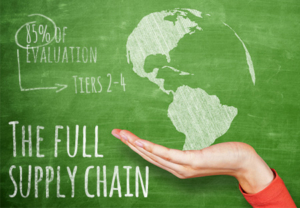
The New Economics of Supply Chain Sustainability
Finance programs reward supplier CSR efforts
In 2010, athletic footwear and apparel manufacturer PUMA set out to monetize the “true costs” of its reliance on nature as a source of critical supplies, such as fresh water, clean air, healthy biodiversity and productive land. The goal, Executive Chairman of PUMA SE Jochen Zeitz reported at the time, was to determine “if our planet was a business, how much would it ask to be paid for the services it provides to a company to operate.” Unable to find a tool to measure this cost, PUMA devised a unique environmental profit and loss (E P&L) accounting framework.
It turns out, the precise amount owed to Mother Earth was less significant than the realization of just how little direct control PUMA had over the brand’s overall environmental impact. The E P&L analysis revealed that PUMA’s core operations – offices, warehouses and stores – accounted for only six percent of its environmental valuation. The remaining 94 percent resided within its extended supply chain, with 85 percent occurring in tiers two through four – segments that PUMA, like many other large companies, tended to under scrutinize.
“Analysis revealed that PUMA’s core operations – offices, warehouses and stores – accounted for only six percent of its environmental valuation. The remaining 94 percent resided within its extended supply chain.”

As part of its sustainability targets for 2020, PUMA committed to keeping closer tabs on social and environmental matters across its “full supply chain.” But the company’s stewardship was hampered by a limited ability to influence the environmental conservation and social responsibility activity of hundreds of small and medium enterprises within the extended, increasingly global, supply chain.
Corporate sustainability and responsibility (CSR) ratings and supplier scorecards have proven moderately successful for many organizations, but motivation is not the biggest compliance obstacle for most small businesses; available resources are. How much can a specialty textile maker in India, or a tin smelter in Brazil, afford to invest in social and environmental programs when they are struggling to make ends meet and under pressure to upgrade equipment and operations to meet stringent productivity and quality standards of their large multinational customers?
Financial institutions like BNP Paribas in Europe and International Finance Corporation (IFC), a member of the World Bank Group, recognized this challenge and have each developed innovative supply chain finance solutions that offer incentives for suppliers to improve environmental, health, safety and humanitarian standards. These kinds of programs tie lending terms not only to the buyer’s credit but also to supplier’s adherence to the buyer’s CSR guidelines.
Innovative supply chain finance programs tie lending terms not only to the buyer’s credit, but also to supplier’s adherence to the buyer’s CSR guidelines.
PUMA is one of the first multinational organizations to implement a CSR-driven financing approach. The program offers tiered pricing of short-term working capital, with lower costs for those suppliers that achieve higher scores in its sustainability rating system. Levi-Strauss & Co. took part in a similar program with IFC in 2014.
Since its launch, PUMA reports that 15 percent of its suppliers have participated in the program, providing more than $100 million in financing. PUMA’s Head of Corporate Sustainability, Stefan Seidel, noted, in a blog on the company’s website, that the program is a way for companies like PUMA to demonstrate their commitment to not only “doing less bad,” but “doing more good.”
 Banks like BNP Paribas have helped reduce fiscal sustainability risk among extended supply chains by offering supplier finance programs that leverage the financial strength of the buyer to give cash-strapped suppliers access to affordable financing. Adding an environmental and social sustainability component to these programs to mitigate CSR risk is the logical next step, according to Suresh Subramanian, managing director, head of trade and treasury solutions, Americas, BNP Paribas. Such programs are a natural fit for BNP, added Julian Oldale, head of product, innovation and business performance, trade and treasury solutions, Americas for BNP Paribas. “We have a strong CSR policy in place. Thus, it is important to us that we finance in a sustainable fashion.”
Banks like BNP Paribas have helped reduce fiscal sustainability risk among extended supply chains by offering supplier finance programs that leverage the financial strength of the buyer to give cash-strapped suppliers access to affordable financing. Adding an environmental and social sustainability component to these programs to mitigate CSR risk is the logical next step, according to Suresh Subramanian, managing director, head of trade and treasury solutions, Americas, BNP Paribas. Such programs are a natural fit for BNP, added Julian Oldale, head of product, innovation and business performance, trade and treasury solutions, Americas for BNP Paribas. “We have a strong CSR policy in place. Thus, it is important to us that we finance in a sustainable fashion.”
“The program is a way for companies like PUMA to demonstrate their commitment to not only ‘doing less bad,’ but ‘doing more good.’”
Although there are not many offerings currently in the market that tie supply chain finance and CSR, Subramanian expects the concept to gain momentum, especially since social media forces transparency throughout the supply chain. “Consumers are holding corporates accountable,” Subramanian said.
BNP is also exploring other opportunities with a sustainability angle, including green energy focused supply chain programs and a wind energy inventory program. “We want to focus more on sustainable ventures because it is the right thing to do and it makes business sense,” Subramanian concluded. “When business interests align with doing the right thing, results are more readily achievable.”
Related Resources
- Tool: Environmental Profit & Loss (EP&L)
- Video: PUMA Environmental Profit and Loss
- Report: Kering 2025 Sustainability Strategy
- Report: PUMA’s Environmental Profit and Loss Account for the year ended 31 December 2010
- News Release: International Finance Corporation and Levi Strauss & Co. Reward Garment Suppliers